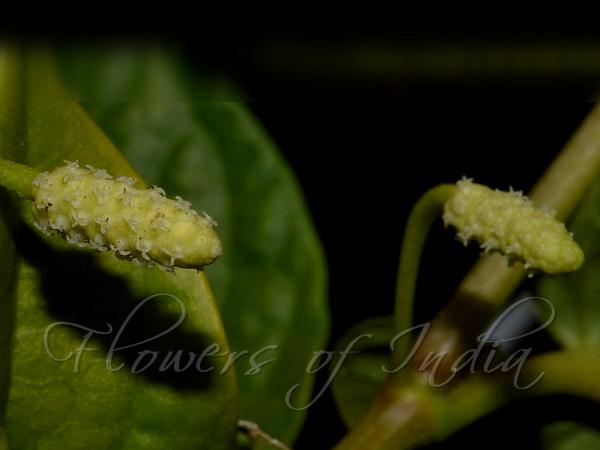|
| Betel Vine |
|

|

| File size | 215806 |
| Original date | 5/10/18 1:53 PM |
| Resolution | 0 x 0 |
| Flash | Flash fired, return detected |
| Focal length | 60.0mm |
| Exposure time | 1/200s |
| Aperture | 22.0 |
| Focus Distance | |
| Metering Mode | Multi-segment |
| Camera make | NIKON CORPORATION |
| Camera model | NIKON D3200 |
| Sensor type | OneChipColorArea |
|
|
|
|
Photo: |
Botanical name: Piper betle Family: Piperaceae (Pepper family)
Synonyms: Piper chawya, Piper malamiris, Piper densum
Synonyms: Piper chawya, Piper malamiris, Piper densum
Betel Vine is an evergreen and perennial creeper, with
glossy heart-shaped leaves, producing woody stems 5-20 m long. The
stems produce adventitious roots, with which they can adhere to other
plants etc for support. Leaves are light green to bright green, glossy,
deeply veined and hairless. They are heart-shaped with entire leaf
margin. Lleaf stalk is reddish like the stem. Flowers are white catkins
developed on the nodes, erect or pendulous. Flowers are small, without
sepal and petal. Fruits are fleshy, spherical to ellipsoidal. The
primary use of betel leaf is as a wrap for chewing of betel nut or
tobacco where it is mainly used to add flavour. Betel vine is native to
India and SE Asia.
Medicinal uses: The leaves, roots and seeds
are all used for medicinal purposes in Asia. Leaf preparations and the
leaf sap are applied to wounds, ulcers, boils and bruises. Heated
leaves are applied as a poultice on the chest against cough and asthma,
on the breasts to stop milk secretion, and on the abdomen to relieve
constipation. The leaves are also used to treat nosebleed, ulcerated
noses, gums and mucous membranes while the extract from the leaves is
applied for wounds in the ears and as an infusion for the eye. A
decoction of the leaves is used to bathe a woman after childbirth, or
is drunk to lessen an unpleasant body odour.
The leaves, roots and seeds
are all used for medicinal purposes in Asia. Leaf preparations and the
leaf sap are applied to wounds, ulcers, boils and bruises. Heated
leaves are applied as a poultice on the chest against cough and asthma,
on the breasts to stop milk secretion, and on the abdomen to relieve
constipation. The leaves are also used to treat nosebleed, ulcerated
noses, gums and mucous membranes while the extract from the leaves is
applied for wounds in the ears and as an infusion for the eye. A
decoction of the leaves is used to bathe a woman after childbirth, or
is drunk to lessen an unpleasant body odour.
Medicinal uses:
 The leaves, roots and seeds
are all used for medicinal purposes in Asia. Leaf preparations and the
leaf sap are applied to wounds, ulcers, boils and bruises. Heated
leaves are applied as a poultice on the chest against cough and asthma,
on the breasts to stop milk secretion, and on the abdomen to relieve
constipation. The leaves are also used to treat nosebleed, ulcerated
noses, gums and mucous membranes while the extract from the leaves is
applied for wounds in the ears and as an infusion for the eye. A
decoction of the leaves is used to bathe a woman after childbirth, or
is drunk to lessen an unpleasant body odour.
The leaves, roots and seeds
are all used for medicinal purposes in Asia. Leaf preparations and the
leaf sap are applied to wounds, ulcers, boils and bruises. Heated
leaves are applied as a poultice on the chest against cough and asthma,
on the breasts to stop milk secretion, and on the abdomen to relieve
constipation. The leaves are also used to treat nosebleed, ulcerated
noses, gums and mucous membranes while the extract from the leaves is
applied for wounds in the ears and as an infusion for the eye. A
decoction of the leaves is used to bathe a woman after childbirth, or
is drunk to lessen an unpleasant body odour. | Identification credit: Saroj Kasaju | Photographed in Kalimpong, West Bengal. |
• Is this flower misidentified? If yes,